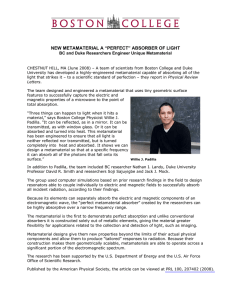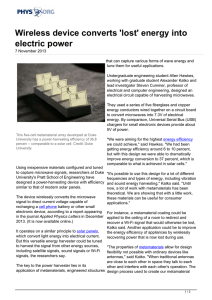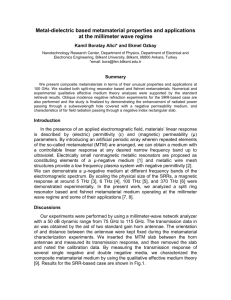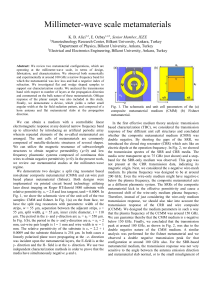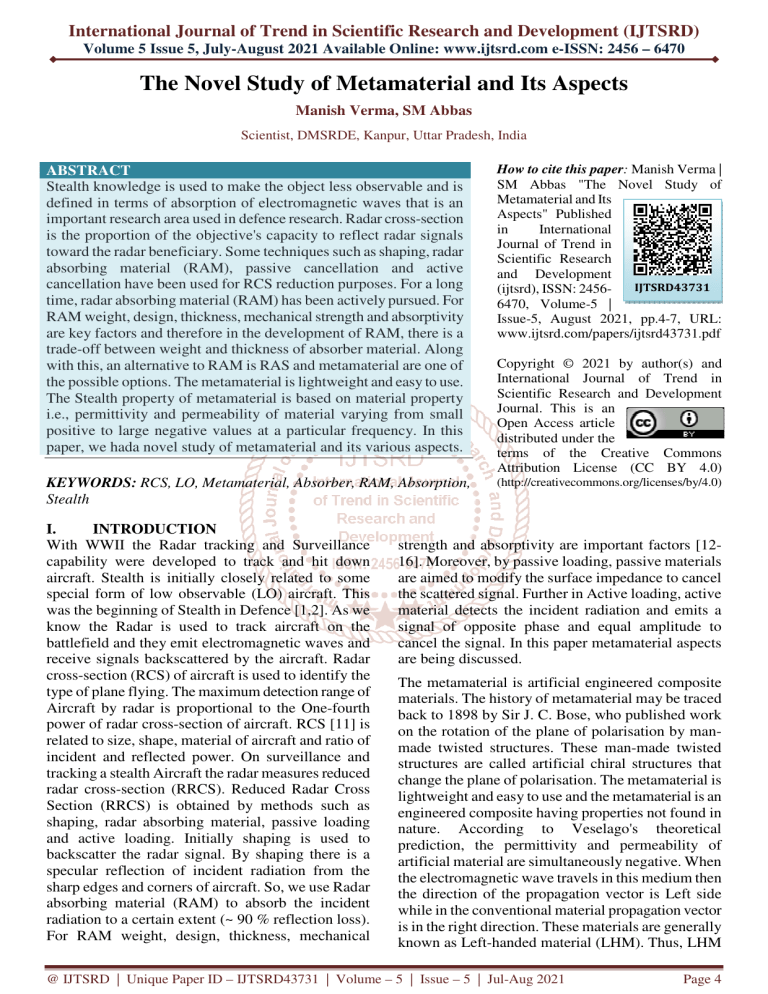
International Journal of Trend in Scientific Research and Development (IJTSRD) Volume 5 Issue 5, July-August 2021 Available Online: www.ijtsrd.com e-ISSN: 2456 – 6470 The Novel Study of Metamaterial and Its Aspects Manish Verma, SM Abbas Scientist, DMSRDE, Kanpur, Uttar Pradesh, India ABSTRACT Stealth knowledge is used to make the object less observable and is defined in terms of absorption of electromagnetic waves that is an important research area used in defence research. Radar cross-section is the proportion of the objective's capacity to reflect radar signals toward the radar beneficiary. Some techniques such as shaping, radar absorbing material (RAM), passive cancellation and active cancellation have been used for RCS reduction purposes. For a long time, radar absorbing material (RAM) has been actively pursued. For RAM weight, design, thickness, mechanical strength and absorptivity are key factors and therefore in the development of RAM, there is a trade-off between weight and thickness of absorber material. Along with this, an alternative to RAM is RAS and metamaterial are one of the possible options. The metamaterial is lightweight and easy to use. The Stealth property of metamaterial is based on material property i.e., permittivity and permeability of material varying from small positive to large negative values at a particular frequency. In this paper, we hada novel study of metamaterial and its various aspects. How to cite this paper: Manish Verma | SM Abbas "The Novel Study of Metamaterial and Its Aspects" Published in International Journal of Trend in Scientific Research and Development IJTSRD43731 (ijtsrd), ISSN: 24566470, Volume-5 | Issue-5, August 2021, pp.4-7, URL: www.ijtsrd.com/papers/ijtsrd43731.pdf KEYWORDS: RCS, LO, Metamaterial, Absorber, RAM, Absorption, Stealth (http://creativecommons.org/licenses/by/4.0) I. INTRODUCTION With WWII the Radar tracking and Surveillance capability were developed to track and hit down aircraft. Stealth is initially closely related to some special form of low observable (LO) aircraft. This was the beginning of Stealth in Defence [1,2]. As we know the Radar is used to track aircraft on the battlefield and they emit electromagnetic waves and receive signals backscattered by the aircraft. Radar cross-section (RCS) of aircraft is used to identify the type of plane flying. The maximum detection range of Aircraft by radar is proportional to the One-fourth power of radar cross-section of aircraft. RCS [11] is related to size, shape, material of aircraft and ratio of incident and reflected power. On surveillance and tracking a stealth Aircraft the radar measures reduced radar cross-section (RRCS). Reduced Radar Cross Section (RRCS) is obtained by methods such as shaping, radar absorbing material, passive loading and active loading. Initially shaping is used to backscatter the radar signal. By shaping there is a specular reflection of incident radiation from the sharp edges and corners of aircraft. So, we use Radar absorbing material (RAM) to absorb the incident radiation to a certain extent (~ 90 % reflection loss). For RAM weight, design, thickness, mechanical Copyright © 2021 by author(s) and International Journal of Trend in Scientific Research and Development Journal. This is an Open Access article distributed under the terms of the Creative Commons Attribution License (CC BY 4.0) strength and absorptivity are important factors [1216]. Moreover, by passive loading, passive materials are aimed to modify the surface impedance to cancel the scattered signal. Further in Active loading, active material detects the incident radiation and emits a signal of opposite phase and equal amplitude to cancel the signal. In this paper metamaterial aspects are being discussed. The metamaterial is artificial engineered composite materials. The history of metamaterial may be traced back to 1898 by Sir J. C. Bose, who published work on the rotation of the plane of polarisation by manmade twisted structures. These man-made twisted structures are called artificial chiral structures that change the plane of polarisation. The metamaterial is lightweight and easy to use and the metamaterial is an engineered composite having properties not found in nature. According to Veselago's theoretical prediction, the permittivity and permeability of artificial material are simultaneously negative. When the electromagnetic wave travels in this medium then the direction of the propagation vector is Left side while in the conventional material propagation vector is in the right direction. These materials are generally known as Left-handed material (LHM). Thus, LHM @ IJTSRD | Unique Paper ID – IJTSRD43731 | Volume – 5 | Issue – 5 | Jul-Aug 2021 Page 4 International Journal of Trend in Scientific Research and Development @ www.ijtsrd.com eISSN: 2456-6470 has a pointing wave vector in a backward direction as compared to right-handed materials. Due to its specific properties, LHM has been of special interest to defence applications, particularly stealth. The present material shows that when a left-handed material is used in an electromagnetic wave absorber, more effective impedance matching can be done, and absorption bandwidth can be expanded more. This shows that left-handed material may be one of the materials used to design electromagnetic wave absorbers with good absorbability. Based on the broad application of metamaterial from photovoltaic to stealth, novel applications as metamaterial perfect absorbers are also possible. For all metamaterial absorbers studied so far are in the frequency of operation in GHz/THz/IR, it can be used for defence purposes too. In this paper, we are going to discuss a few aspects of metamaterial in brief. II. CONCEPT OF METAMATERIAL The metamaterial is made of building blocks in the same manner as the matter is made up of atoms. Also, these building blocks are made up of conventional materials. Metamaterial is usually lightweight and easy to use and is the next level of the structural hierarchy of atoms. The idea of metamaterial is depicted in Figure 1. the propagation vector is in the Left direction. He establishes that in metamaterial the electric field vector E. the magnetic field vector H and the propagation wave vector k of a plane electromagnetic waveform a left-handed system and these materials are possible. The electromagnetic wave will convey energy in the direction opposite to phase velocity. Also, they obey the law of electrodynamics. These materials are also known as Left-handed material. Figure 2: Plane-wave in LHM The Maxwell equation for the plane harmonic wave is given as (1) Electric Field E, magnetic field H and propagation vector k form a left-hand orthogonal system at close to resonance frequency for material having real part of electrical permittivity and magnetic permeability to be negative. Medium possessing these values is a lefthanded medium (LHM) or DNG medium. In DPS medium these vectors form right hand system[5,6]. The equation of energy density for DNG medium is Figure 1 Metamaterial with the many options for inclusions [3,10]. From figure 1 metamaterial can have any shape and size of its structural building blocks like split ring resonator (SSR), hat resonator (HR), coupled ring resonator (CRR) etc. Generally, metamaterial imply a crucial case of a periodic lattice of identical elements and thereby analogous for the crystal. The metamaterial is an artificial engineered composite material with properties not found in nature. The metamaterial is having various properties like reversed Doppler Effect, reversed Cerenkov radiation, negative refractive index, super lenses, solar radiation absorber. III. THEORY OF METAMATERIAL Metamaterial was first coined in the late 1990s[4,5]. Given Veselago's theoretical prediction that the permittivity and permeability of metamaterial are simultaneously negative. When an electromagnetic wave propagates in this medium, then the direction of (2) The necessary condition for energy density simultaneous negative permittivity and permeability is (3) This does not require ‘ε’ and ‘µ’ to be simultaneously negative. But the DNG medium should necessarily be dispersive [7]. IV. APPLICATIONS OF METAMATERIALS Metamaterials have shown several effects and devices such as cloaking, superlenses, negative refraction, etc., in which the µ, ε will be satisfied by periodic/ non-periodic arrays of magnetic or electric resonant/ @ IJTSRD | Unique Paper ID – IJTSRD43731 | Volume – 5 | Issue – 5 | Jul-Aug 2021 Page 5 International Journal of Trend in Scientific Research and Development @ www.ijtsrd.com eISSN: 2456-6470 non-resonant. The idea of simultaneous negative permeability and permittivity was given by Veselago in 1968. The idea was realized by Smith et al [6] in 2000 demonstrating a composite medium based on a periodic array of inter-gap conducting SRR and continuous wires that shows frequency region in microwave region with simultaneously negative values of effective permeability and permittivity. Based on the above notion, electromagnetic absorbers have been suggested where the path of the electromagnetic wave is controlled by introducing spatial variation in permeability and permittivity parameters. Absorbers are basically of two types namely, (a) interference absorbers, where reflection occurring at the front surface of absorbers are cancelled by destructive interference with wave entering the layers and subsequently emergence (b) antireflection coatings, where the absorber material is so designed that no reflection takes place at the frontfacing surface and the attenuation in the layer extinguishes the, entering waves [8]. The metamaterial absorbers are made of periodic subwavelength resonators and are considered homogeneous mediums. The absorption in the capability of metamaterial-based structures is entirely dependent on the thickness and various structural parameters of the periodic patterns. Metamaterial absorbers have shown an increase in reflection loss as compared to absorbers without layers of the metamaterial. As the number of layers of metamaterial is increased it found that reflection loss also increases as compared to simulated results. Tao et al. [9] designed the absorbers for the terahertz frequency region. The strong absorption coefficient makes this metamaterial spectrally selective THz absorber. This is used in RCS reduction technology at terahertz frequency where estimation of RCS of the bigger object is accurate possible. Thus, the THz metamaterial absorbers are engineered composite that may be used in stealth. stealth properties. Thus, RCS reduction may be done by Metamaterial. V. CONCLUSION There are a lot of opportunities for metamaterial absorbers in the microwave and THz frequencies. Metamaterial has a great deal of research interest in high-frequency absorber applications. Due to their resonant nature most of the metamaterial operate over a narrow spectral range, impetus has been on making absorbers with high-frequency tenability and broadband/ multiple functionalities that support stealth uses. Several metamaterial absorbers development and theory are put forward for further applications. Thus, metamaterial absorbers are electromagnetic wave absorbers that are lightweight and easy to use and metamaterial absorbers are engineered composite having varying degrees of ACKNOWLEDGEMENT We are highly thankful to N.E.Prasad, Sc-‘H’. Director DMSRDE, Kanpur for his support for this research works on metamaterial and its relevance to stealth. Also, we are thankful to Sarvesh Kumar, Sc'F', Bhavana Srivastava, TO- ‘A’ for their support and valuable inputs in this research paper. REFERENCES [1] Stonier, Roger A. "Stealth Aircraft and Technology from World-War-II to The Gulf. 2. Applications and Design." Sampe Journal 27.5 (1991): 9-18. [2] John, D., and M. Washington. "USAF unveils stealth fighter." Aviat Week Space Technol 129.November 14 (1988): 28-29. [3] Nanostructured Metamaterials brochure. EUROPEAN COMMISSION. Editor in Chief Anne F. de Baas. [4] Lakhtakia, Akhlesh, Werner S. Weiglhofer, and Ian J. Hodgkinson. "Complex mediums II: Beyond linear isotropic dielectrics." Complex Mediums II: Beyond Linear Isotropic Dielectrics 4467 (2001). [5] Cai, Wenshan, and Vladimir M. Shalaev. Optical metamaterials. Vol. 10. No. 6011. New York: Springer, 2010. [6] Kumar, M. Ashok, N. P. Anusha, and Alok Sharan. "FDTD Modelling of 1D Photonic Crystal for Thermal Masking Application with CPML Absorbing Boundary Condition." Defence Science Journal 67.2 (2017). [7] Smith, David R., et al. "Composite medium with simultaneously negative permeability and permittivity." Physical review letters 84.18 (2000): 4184. [8] Chatterjee, S. K., and Rajeswari Chatterjee. "Some Recent Advances in Microwaves A Review." Defence Science Journal 40.1 (1990): 25. [9] Tao, Hu, et al. "Highly flexible wide angle of incidence terahertz metamaterial absorber: Design,fabrication,and characterization." physical review B 78.24 (2008): 241103. [10] Zheludev, Nikolay I., and Yuri S. Kivshar. "From metamaterials to metadevices." Nature materials 11.11 (2012): 917-924. [11] Verma, Manish, S. M. Abbas, and N. E. Prasad. @ IJTSRD | Unique Paper ID – IJTSRD43731 | Volume – 5 | Issue – 5 | Jul-Aug 2021 Page 6 International Journal of Trend in Scientific Research and Development @ www.ijtsrd.com eISSN: 2456-6470 "RCS reduction in context of technology: Theoretical Aspects." stealth [12] Tripathi, K. C., et al. "Electromagnetic & microwave absorption properties of Carbon black/PU di-electric Nano-composite absorber." IJSART 1.7 (2015). [13] Tripathi, K. C., et al. "Microwave Absorption Properties of Carbon Black Nano-filler in PU based Nano-composites." IJARSET 3.2 (2016). [14] Tripathi, K. C., et al. "Electromagnetic and Microwave Absorption Properties of Ni0. 5 Zn0. 5 Fe2O4 Nano Ferrite/PU Based NanoComposite." (2015): 19-25. [15] Tripathi, K. C., et al. "Preparation and EM Absorption Properties of Gamma (γ) NanoFerrite in Epoxy Based Nano-Composites." [16] Tripathi, Krishna Chandra, et al. "Microwave absorbing properties of MWCNT/Carbon black-PU Nano-composites." 2017 IEEE International Conference on Power, Control, Signals and Instrumentation Engineering (ICPCSI). IEEE, 2017. @ IJTSRD | Unique Paper ID – IJTSRD43731 | Volume – 5 | Issue – 5 | Jul-Aug 2021 Page 7
